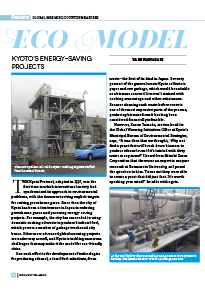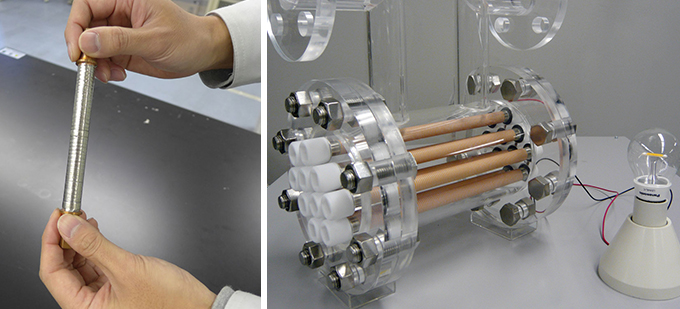Home > Highlighting JAPAN >Highlighting Japan February 2015>Global warming countermeasures
Highlighting JAPAN

Global warming countermeasures
Eco Model
Kyoto’s energy-saving projects

The Kyoto Protocol, adopted in 1997, was the first time in which international society had synchronized its approach to environmental problems, with the document setting explicit targets for cutting greenhouse gases. Since then the city of Kyoto has been a frontrunner in Japan in reducing greenhouse gases and pursuing energy-saving projects. For example, the city has succeeded in using domestic cooking oil waste to produce biodiesel fuel, which powers a number of garbage trucks and city buses. Other more advanced global warming projects are under way as well, and Kyoto is tackling numerous challenges that may make it the model for eco-friendly cities.
One such effort is the development of technologies for producing ethanol, a fossil fuel substitute, from waste—the first of its kind in Japan. Seventy percent of the general waste Kyoto collects is paper and raw garbage, which would be suitable as a biomass source if it weren’t stained with cooking seasonings and other substances. Because cleaning such waste before reuse is one of the most expensive parts of the process, producing biomass from it has long been considered financially infeasible.
However, Kazuo Yamada, section head for the Global Warming Initiatives Office at Kyoto’s Municipal Bureau of Environmental Strategies, says, “It was then that we thought, ‘Why not find a yeast that will break down biomass to produce ethanol even if it’s tainted with dirty water or soy sauce?’ I heard from Hitachi Zosen Corporation that there was an expert in enzyme research at Kumamoto University, so I posed the question to him. Turns out they were able to create a yeast that did just that. It’s worth speaking your mind!” he adds with a grin.
In this industry-academia-government partnership, the city of Kyoto, Kumamoto University and Hitachi Zosen Corporation worked together and were selected to receive funding from the Ministry of the Environment. Experimental trials are already being performed. Yamada’s humor is reflected in the name of the project, dubbed the Metropolitan Oil Field Project, since a fossil fuel alternative can be produced from household waste.
Currently ethanol sells for around 140 yen per liter in Kyoto. However, at the current stage, one liter of ethanol can be produced for under eighty yen using the newly developed method, and it is expected to be ready for mass production after the 2015 fiscal year.
Kyoto has also joined forces with Panasonic to develop a thermoelectric tube, which is already undergoing experimental trials. Two types of metal are fused and made into this specialized tube: when hot water is piped through it, electricity is generated from the temperature difference. The tubular shape, along with the use of thermally conductive materials, ensures efficient heat transfer even with lukewarm water, so the tube can harness everyday heat sources like hot water, steam and exhaust for energy. This technology has been designated for inclusion in the New Energy and Industrial Technology Development Organization’s projects. In Kyoto’s pilot project, Yamada has designed a testing plant with Panasonic’s system, and is conducting field tests using the heat generated during the incineration phase at waste treatment facilities.
“The tubes themselves are used as generators—this is the first system of its kind worldwide,” says Tsutomu Kanno, research lead for Panasonic’s advanced research division, pointing at the device, which is small enough to fit in two hands. Tubes this small can easily fit into automobiles, factories and water supply systems in buildings to generate power. This revolutionary and efficient technology will provide “a stable energy supply that contributes to the creation of a sustainable energy society,” says Kanno. Panasonic is pursuing further size reductions and gearing up for mass production so that it can bring the product to market.
In Kyoto, a city in which the traditions of the past are still vibrant, there are people engaged in innovative, energy-saving technologies. Every one of them was full of vigor and their own kind of energy. The creative spirit of enterprise and experimental drive these researchers display powerfully supports Japan’s international competitiveness.
© 2009 Cabinet Office, Government of Japan






